In 1610 Galileo, now considered the father of modern science and observational astronomy, began to publicly support the belief that the sun, not the earth, was the center of our universe. His heliocentric beliefs met with bitter opposition from his peers and the church who condemned him as a heretic. It was no coincidence, as it has always been, that those who benefit most from the status quo prove to be the most resistant to any kind of opposing thought, no matter how much sense it makes.
After a year of exploring the nature of influence, I firmly believe I am now, and have always been, inconsequential. That being said I also believe, like Galileo did about the sun and earth, that our view of influence is strongly based on the beliefs of those that benefit from it the most. This current self-centered view of influence puts man/woman as the center of the influence universe – a view I do not share and believe to be the exact opposite of the truth; a truth many would consider heresy.
So what if something else is the center and we all orbit around it? Perhaps its more than one thing where we are torn and pulled into different orbits as we near forms of influence with stronger gravity?
In my mind, a form of influence known as “Situational Influence” is the center of the universe we all orbit. I will be exploring this topic over the next while in a three part series; the first part of which is the Nature of Situational Influence..
The Power of Situational Influence
If we think deeply and track back our actions in life many of us would see a series of situations that propelled our actions and became the major influence in all of our big decisions. Indeed, if we look at the myriad of small decisions we make each and every day, we will see our priorities are affected and shaped by a series of interconnected events and situations that rise and fall as they collide against each other and challenge our values, beliefs and perceptions to drive behavior.
The basics keys on Situational Influence…
- Situations directly affect action.
- Situations rise in priority according to urgency.
- Urgency drives immediacy of action
- We are oblivious to all of it.
Now, with that in mind, I am going to illustrate how this works using a rain metaphor and will return to our planetary metaphor in Part 2 and 3 of this series. But for now, rain is an excellent way to understand Situational Influence in its simplest form.
The Coming Storm
Have you ever been caught in the rain or a sudden storm? Imagine back to how that affected what you were doing and how you changed your behavior to cope with the rain or escape the storm. Our actions changed according to how intense the rain or storm became. As it rose in intensity, it drove more immediate action in us.
The nature of situational influence works in much the same and is amplified by urgency.
In the above illustration, Situational Influence is represented by four distinct states of rain from Drizzle, Rain, Storm to a Flood. Underneath these is how the urgency of situation makes it rain harder thus creating a more directly influential situation. While the examples underneath give examples of what can be possible motivating situations at each stage of rain.
Obviously, it would also be best to represent rough percentages that each person would experience each form of situational influence. While I am no statistician, I have assigned some arbitrary values to each based on the loose definitions and examples from above.
Further, if we wanted to really explore this metaphor we can add another factor which would be duration of the situation. The interesting attribute to duration is that while a duration can vary wildly anywhere from instant to a whole lifetime such as an illness, it can be applied to any situation and any state of urgency. For example, you can be laid off and be out of work for a day or you can be out of work for years. An illness can be instant like food poisoning or a lifetime like cancer.
So what we have are 3 factors which help put basic boundaries of understanding around situational influence…
- Type of Situation: Drizzle, Rain, Storm, and Flood.
- Level of Urgency: Mild, Medium, High and Life Changing.
- Duration: From Instant to Lifetime; a single second to decades.
With this in mind, let’s now explore how a situation affects a single person such as one of your customers, and for this purpose i will stick to a consumer, although Situational Influence affects businesses equally.
Of Umbrellas, Shelters and Arks
Again I am going to ask you to remember back to being caught in a sudden rain storm without any kind of shelter or way to keep the rain of you. How did that make you feel? For most people, its not a good experience. So, if we continue that imagining so as to now picture that person in the rain as a customer in a situation and let’s assume its a negative situation. Like anyone caught in rain, the customer is looking for something to protect them from the rain such as an umbrella.
For me, an umbrella is a great way to represent an experience a company can design to protect a customer from a rainy situation. The umbrella experience delivers the potential of several things:
- It is the opportunity to turn a negative situation quickly into a positive situation.
- It arms the customer with ability to endure, solve or minimize a negative situation.
- It gives the customer something they can share with another because who hasn’t at one time shared an umbrella?
A great example of a rain situation and an umbrella/no umbrella experience is the following:
No umbrella: A mobile customer is having issues with their mobile device and attempts to get hold of technical or customer support. The longer it takes to get resolution, the more rain falls on them and the more negative they become.
Umbrella: The same mobile customer is having issues with their mobile device and goes to the companies Twitter support channel (the umbrella experience) for fast, effective assistance. In this case, the customer is protected from the rain and is likely to share that “umbrella” with others who are in the rain.
Now an umbrella will do you no good in a serious storm or a flood which brings us to two stronger forms of experience; the Shelter experience and the Ark experience.
In bad times, give them shelter…
Now, we are going to increase the intensity to recall a time when we were caught in a fierce thunder storm with driving rains, lightning strikes and booming thunder. For me, I distinctly remember a fair amount of fear when I was a boy and which grew into respect for the power of storms as an adult. But as a child, I had no way to deal with it until my mother taught me the counting game and I’m sure most everyone knows this one. Basically, from the moment you see lightning you count Mississippis until you hear thunder. If the count gets higher between the two, the storm was lessening. If it the count gets lower, the storm was getting worse. Now here’s the thing, as a kid, I would keep counting until the storm lessened because I was given a way to cope with the fear it created in me. It didn’t matter that it lasted 6-7 hours, I would keep counting.
As a customer, there are situations in life where you need shelter from a lengthy or intense storm – the kind that disrupts your life and impacts your emotional well being. The Shelter experience is designed to help through more difficult or prolonged situations. Again, give them somewhere to go and someone or something to rely on. In this case the shelter could be a no hassle service (shelter) on getting a customer who has been in a car accident back on track instead of giving them a hard time (no shelter). But the important thing to do is give them, at the very minimum, a shelter experience based on your own version of the counting game to get them through the storm. They need to know you are down the hall and the storm, while intense and scary now, will go away if they keep counting.
Or follow Noah’s example and build an Ark…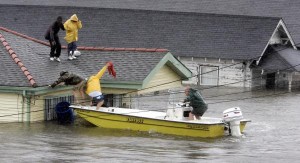
In the late summer/early fall of 1988 in lived in Edmonton Alberta, Canada – a polite agricultural part of Canada much like the US Mid West. Now, Alberta can get some pretty severe weather and it can come out of nowhere. This one particular day we experienced what would become to known as the worst tornado event in Canadian history. I was eighteen at the time and stuck in traffic on a highway outside Edmonton when the sky turned ominous, the winds picked up and the hail began. Up to this point, it was pretty status quo for Alberta storms, but the wind kept growing in ferocity. I will never forget the feeling I had when I saw the funnel come down about ten miles away and begin to rip through south eastern Edmonton. That Tornado went on to devastate a large part of the city and killed many people. The clean-up, which I volunteered to do with many, many others, hit home with me. These folks literally lost everything.
Now apply that kind of devastating situation metaphorically to one of your customers. When the absolute worst happens, you need to get that customer safely out of the way of the flood. Examples of these types of situations abound from the death of a loved one to losing your home. An Ark experience, while not likely to happen often, is a part of a more complex customer/advocacy support program. If you can’t get them in the Ark, then build your Ark experience around helping them rebuild or build their lives after a major life-changing event. The Word of Mouth Marketing power that comes from Ark experiences is enough value in and of itself to strongly consider doing it. If you leave them stranded, not only will they never forget that, but someone else might save them.
Before it Rains, Hand out the Umbrellas
So understanding the basics of Situational Influence means we can begin to map out the types of common situations that affect our customers. Even starting at the lowest form, Drizzle situations – those mild, mostly inconvenient situations that eat time out of our already busy schedules, gives us the opportunity to create a simple, highly effective umbrella experiences to deal with many of those for our customers. The best place for it? Customer service by far. Here are the questions you need to answer:
- What situations affect my customers?
- How do these situations affect my customers?
- How do they resolve these situations now?
- How can we make this easier, faster for them?
- What is the umbrella experience?
- What do we need to do in order to fulfill/deliver/enable that umbrella experience?
The key to success before you start? Make sure the customer is involved in answering every single question! Without customer involvement you will fail. If however you follow this formula, you can start handing out umbrellas to your customers before it starts to rain. Chances are they will share that umbrella with others over and over.
That last question I have in my mind regarding Situational Influence in this post is: Once we hand out the umbrellas, can we find a way to make it rain? By that I mean, is there a way to increase urgency for positive situations? Customer fulfillment is an often overlooked way to not increase share of wallet but also improve customer referrals and Word of Mouth marketing. By encouraging more active participation in your umbrella experience, you naturally drive more mutual benefit.
The best example I can think of is Starbucks Customer Engagement program – My Starbucks Idea. If you haven’t checked it out, it is a shining example of how a company created an umbrella experience, delivered exclusively online, that increases urgency for participation in the community by rewarding involvement with both recognition and rewards (Ideas in Action and Leader Board). The point is, by being customer-centric, providing a community devoted to the experience the love, giving the customer a means to use their voice and see action, Starbucks has successfully improved the urgency to become involved actively in the brand. They are essentially making it rain by creating a positively influential environment and situation for their customers.
To leave you with a thought… I can’t help but picture the scene of “Singing in the Rain” where Gene Kelly has his solo dance/song scene overwhelmed with the joy of having spent a fine evening with a lovely woman. His joy and energy are inspiring and fantastic to behold. It is a powerful reminder that rain can be enjoyed if you have the right attitude.
Let’s make sure we work hard to build that attitude in our customers.
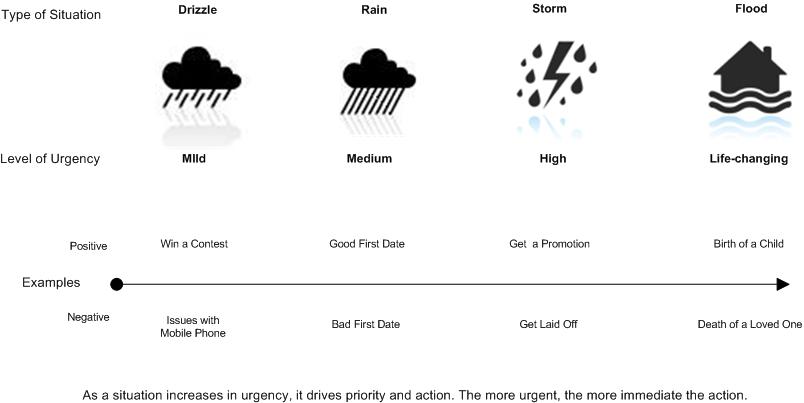
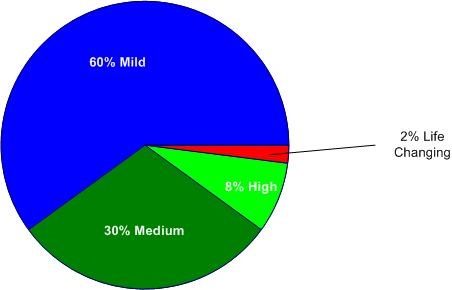
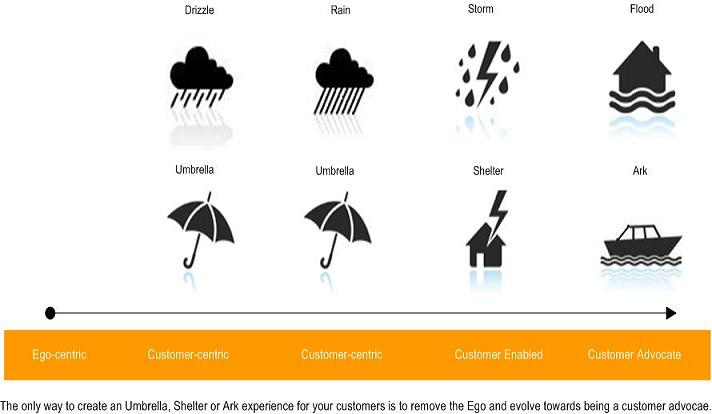
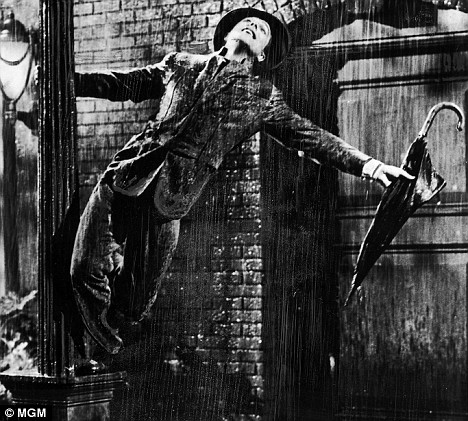
Jeff:
Situation is an incredibly important component of influence online. The thing that many miss is that online and offline influence have many similar components, it’s just that the proverbial “soap box” allows people to broadcast them to a wider audience. Very good post and information that everyone should consider when determining what the measure and definition of influence really means … and to understand that it always changes. Being influential today doesn’t guarantee the same amount of impact tomorrow — and popularity is certainly not influence, but can contribute to it based on a person’s actions. My twenty two cents …
Best,
@IanGertler
Comment by Ian Gertler — May 16, 2011 @ 5:29 am
Hi Ian,
Yes, online and offline influence both work together and against each other. My work has focused on identifying different forms of influence and how these “layers” affect each other especially in a state of constant flux. Its fascinating and very enjoyable to say the least. But certainly, how we measure influence and even how we define it is in question, if not now, in the very near future.
Thanks very much for reading and taking the time to comment.
Cheers!
Jeff – Sensei
Comment by Jeff — May 16, 2011 @ 5:42 pm
Brilliant article.
Will be loooking out for par two and three for sure!
Great analogy of the rain storm, and I really like the way you encourage having a customer centric strategy for dealing with the problems and situations they are likely to face. Have always been keen on being customer centric and client focused, but after reading this you can be sure we’ll be reviewing our systems soon to see where we can improve and cater better.
I did wonder how you were bringing it back to influence and the client at the beginning of the article but the “umbrella experience” is so clear and real, and with a little forward planning so manageable.
With amazing rewards to… at the end of the day who doesn’t like to talk about great service.
Great writing man.
Thanks again.
Comment by Kwesi Raphael — May 16, 2011 @ 7:00 am
Hi Kwesi,
I am glad you appreciated the rain metaphor. Weather is something we can all understand and relate to. I am pleased to hear that the article has lead to a shift in your thinking as well! Being customer-centric means constant improvement and awareness of changing customer needs.
Is there anything i can build on in Paert 2 and 3 for you? Always appreciate the questions, challenges and insights of my peers in my writing.
Thanks very much for taking the time to read and comment. Please keep me informed as you hand out your own umbrellas!
Jeff – Sensei
Comment by Jeff — May 16, 2011 @ 6:01 pm
Jeff — when I paste a url into my reading list I know it struck a nerve; this one did – thanx for more food for thought. The questions I’ve been wrestling with have been 1) how does influence work? (what levers can a marketer possibly affect?), 2) how does content impact choice? (what are the dimensions of content that affect decisions in different need states or situations?) and 3) how does a message penetrate a consumer’s ozone layer that filters out most messages? (how do we communicate in what is best described as a fluid fog).
An early attempt at the first was . Looking forward to the next iterations…..
cheers
anthony
Comment by Anthony Power — June 17, 2011 @ 6:03 am
Hi Anthony,
Honoured by your reply. You give me some interesting things to think about as well in the role of content and, as you suggest, the many dimensions of content for their role in situational influence. I will be publishing more thinking on situational influence shortly and look forward to your thoughts on that.
Cheers to a fellow explorer!
Jeff – Sensei
Comment by Jeff — June 17, 2011 @ 10:41 am